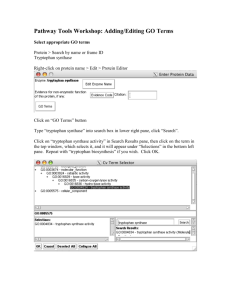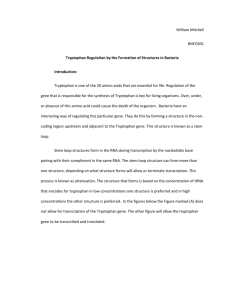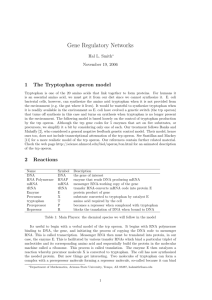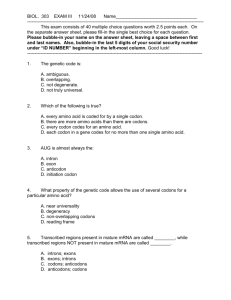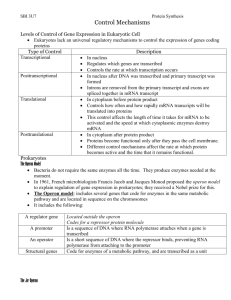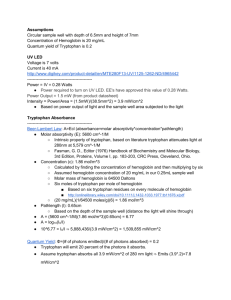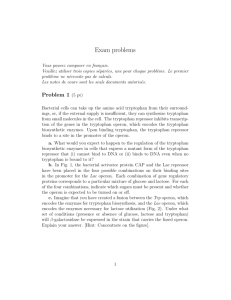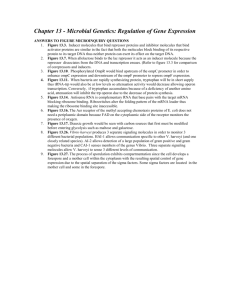Here - Oregon State University
advertisement
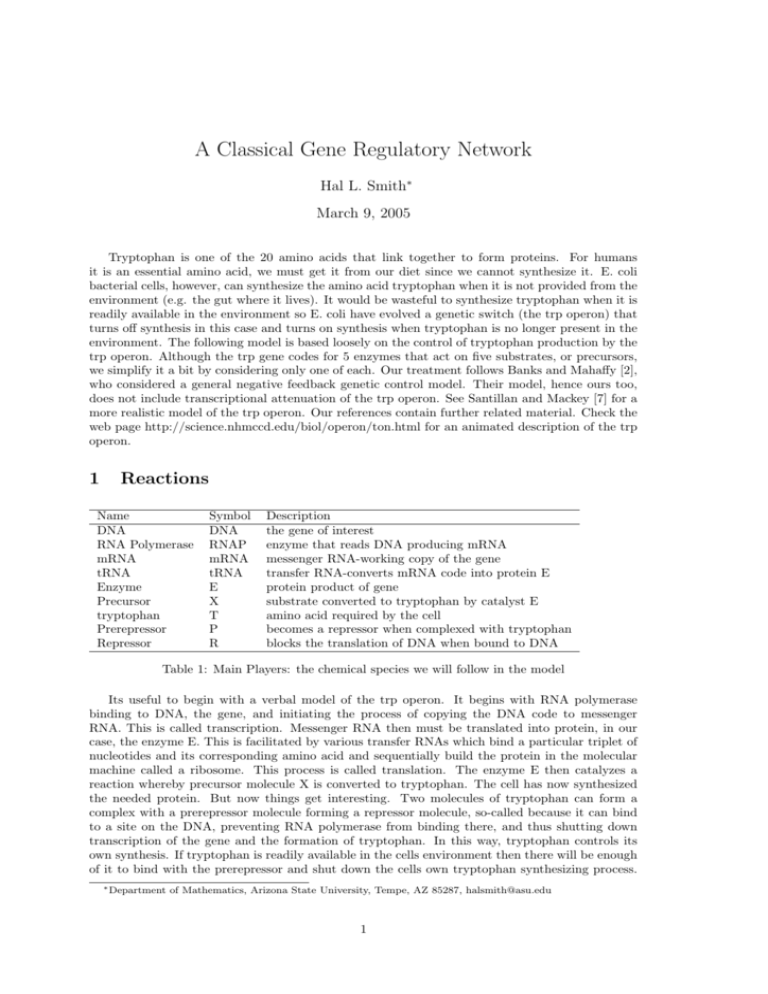
A Classical Gene Regulatory Network
Hal L. Smith∗
March 9, 2005
Tryptophan is one of the 20 amino acids that link together to form proteins. For humans
it is an essential amino acid, we must get it from our diet since we cannot synthesize it. E. coli
bacterial cells, however, can synthesize the amino acid tryptophan when it is not provided from the
environment (e.g. the gut where it lives). It would be wasteful to synthesize tryptophan when it is
readily available in the environment so E. coli have evolved a genetic switch (the trp operon) that
turns off synthesis in this case and turns on synthesis when tryptophan is no longer present in the
environment. The following model is based loosely on the control of tryptophan production by the
trp operon. Although the trp gene codes for 5 enzymes that act on five substrates, or precursors,
we simplify it a bit by considering only one of each. Our treatment follows Banks and Mahaffy [2],
who considered a general negative feedback genetic control model. Their model, hence ours too,
does not include transcriptional attenuation of the trp operon. See Santillan and Mackey [7] for a
more realistic model of the trp operon. Our references contain further related material. Check the
web page http://science.nhmccd.edu/biol/operon/ton.html for an animated description of the trp
operon.
1
Reactions
Name
DNA
RNA Polymerase
mRNA
tRNA
Enzyme
Precursor
tryptophan
Prerepressor
Repressor
Symbol
DNA
RNAP
mRNA
tRNA
E
X
T
P
R
Description
the gene of interest
enzyme that reads DNA producing mRNA
messenger RNA-working copy of the gene
transfer RNA-converts mRNA code into protein E
protein product of gene
substrate converted to tryptophan by catalyst E
amino acid required by the cell
becomes a repressor when complexed with tryptophan
blocks the translation of DNA when bound to DNA
Table 1: Main Players: the chemical species we will follow in the model
Its useful to begin with a verbal model of the trp operon. It begins with RNA polymerase
binding to DNA, the gene, and initiating the process of copying the DNA code to messenger
RNA. This is called transcription. Messenger RNA then must be translated into protein, in our
case, the enzyme E. This is facilitated by various transfer RNAs which bind a particular triplet of
nucleotides and its corresponding amino acid and sequentially build the protein in the molecular
machine called a ribosome. This process is called translation. The enzyme E then catalyzes a
reaction whereby precursor molecule X is converted to tryptophan. The cell has now synthesized
the needed protein. But now things get interesting. Two molecules of tryptophan can form a
complex with a prerepressor molecule forming a repressor molecule, so-called because it can bind
to a site on the DNA, preventing RNA polymerase from binding there, and thus shutting down
transcription of the gene and the formation of tryptophan. In this way, tryptophan controls its
own synthesis. If tryptophan is readily available in the cells environment then there will be enough
of it to bind with the prerepressor and shut down the cells own tryptophan synthesizing process.
∗ Department
of Mathematics, Arizona State University, Tempe, AZ 85287, halsmith@asu.edu
1
However, if the external supply of tryptophan is abruptly shut off, the internal concentration
will decline as the cell uses up its supply of tryptophan and eventually there will be too little
bound with prerepressor forming repressor so RNA polymerase is free to bind to DNA and initiate
transcription which leads to tryptophan synthesis. This is a very simple switch! Now lets say this
mathematically.
We now give a set of chemical reactions describing the interaction of the above mentioned
molecules. In formulating equations for the concentrations of these chemical species we must
acknowledge that a single cell may not contain sufficiently many molecules of a particular chemical
species to justify a continuum model. For example, a typical cell will have only one copy of the
gene. Therefore, to justify our model we must focus not on a single cell but rather on a collection
of synchronously dividing cells, which will contain large numbers of the relevant chemical species.
Transcription:-RNA Polymerase reads DNA copying the DNA instructions into an mRNA ”transcript”:
RN AP + DN A À RN AP : DN A → mRN A + DN A + RN AP
with rate constants k1+ , k1− , k1. Subscript ”+” indicates forward reaction and subscript ”” indicates the backward reaction in ¿. RNAP:DNA denotes a complex formed when RNA
Polymerase binds to DNA. It can either unbind into its constituents DNA and RNAP or proceed
along the gene segment translating the DNA code to MRNA. We use this ”:” notation to denote
a complex hereafter.
Translation:-tRNA converts mRNA code into protein E:
tRN A + mRN A À tRN A : mRN A → E + mRN A + tRN A
with rate constants k2+ , k2− , k2.
Enzyme catalyzes formation of Endproduct protein T (tryptophan) using precursor X:
X +E ÀX :E →T +E
with rate constants k3+ , k3− , k3.
n molecules of Endproduct combine with a Prerepressor to form Repressor R:
P + nT À R
with rate constants k4+ , k4− . For tryptophan, n = 2.
Repressor binds to DNA making it unavailable for transcription to mRNA:
R + DN A À R : DN A
with rate constants k5+ , k5− .
Most molecules are degraded at some rate:
mRN A
E
→
→
T
→
with rate constants d1, d2, d3. Of course, they degrade to something but we will not need these.
Another interpretation of these loss terms is to imagine an exponentially growing aggregate of cells
in which case all chemical species suffer dilution as each cell roughly doubles in size before dividing.
Thus degradation is merely dilution due to growth. Tryptophan T is also used in other cellular
processes and d3 reflects this demand as well.
Finally, the exterior environment of the cell may provide tryptophan so we include this potential
source
Text → T
with rate constant k6. Of course, the whole point of the tryptophan gene is to be able to synthesize
tryptophan when Text = 0.
2
2
Assumptions
Total DN A is constant-denoted by DN AT .
DN AT = DN A + RN AP : DN A + R : DN A
(2.1)
RNAPolymerase, tRNA, PreRepressor, Precursor concentrations are nearly constant
d
d
d
d
RN AP = tRN A = P = X = 0
dt
dt
dt
dt
Since P is constant, we have:
d
P = k4− (R) − k4+ (P )(T n )
dt
0=
(2.2)
Complexes:
C1 = RN AP : DN A, C2 = tRN A : mRN A, C3 = X : E, C4 = R : DN A
are in equilibrium:
d
Ci = 0,
dt
i = 1, 2, 3, 4
This means:
0 = k1+ (RN AP )(DN A) − (k1− + k1)RN AP : DN A
0 = k2+ (tRN A)(mRN A) − (k2− + k2)tRN A : mRN A
0
0
=
=
k3+ (X)(E) − (k3− + k3)X : E
k5+ (R)(DN A) − (k5− )R : DN A
Using these last equations together with (2.1) and (2.2) we find:
DN AT = (DN A)[1 +
so
DN A =
where
K1 =
3
k1+
k5+
(RN AP ) +
(R)]
k1− + k1
k5−
DN AT
1 + K1 · RN AP + K5K4 · P · T n
k1+
,
k1− + k1
Kj =
(2.3)
kj+
, j = 4, 5.
kj−
Equations
mRN A is involved in both Transcription and Translation. From these two reactions we get:
d
mRN A = k1(RN AP : DN A) − k2+ (tRN A)(mRN A) + (k2 + k2− )tRN A : mRN A − d1 · mRN A
dt
= k1K1(RN AP )(DN A) − d1 · mRN A
DN AT
= k1K1(RN AP ) ·
− d1 · mRN A
1 + K1 · RN AP + K5K4 · P · T n
The protein E is an output of translation and catalyzes formation of T . From these two
reactions we have:
d
E
dt
=
(k3− + k3)(X : E) − k3+ (X)(E) + k2(tRN A : mRN A) − d2 · E
=
k2K2(tRN A)(mRN A) − d2 · E
where K2 is defined similarly as K1.
3
The endproduct T is used by the cell but it also combines with prerepressor to form repressor
R which blocks further formation of T . T may be supplied by the exterior environment of the cell.
d
T
dt
=
k3(X : E) − d3(T ) + nk4− (R) − nk4+ (P )(T n ) + k6(Text )
=
k3K3(X)(E) − d3(T ) + k6(Text )
Let’s relabel mRN A = m and tidy up the equations a bit. Recall that RN AP, tRN A, X, P are
constant so we may write:
β
d
m =
− d1 · m
dt
δ + µT n
d
E = α2 · m − d2 · E
dt
d
T = α3 · E − d3 · T + u
dt
Hopefully, the values of the newly introduced quantities are apparent. For example
δ = 1 + K1 · RN AP
Finally, it will be useful to scale out as many of the parameters as we can. Let
x1 = m/m0 , x2 = E/E0 , x3 = T /T0 , τ = t/t0
(3.1)
where m0 , E0 , T0 , τ0 are reference values to be chosen. Check that these can be selected so as to
achieve the following
x01
=
x02
=
1
− γ 1 x1
1 + xn3
x 1 − γ 2 x2
x03
=
x 2 − γ 3 x3 + u
(3.2)
d
where 0 = dτ
, γi > 0, n = 1, 2, 3, . . . is a positive integer and u ≥ 0 is not the same as above. u = 0
corresponds to a tryptophan-free exterior environment. Equations (3.2) are sometimes referred to
as the “Goodwin Oscillator” after their inventor Brian Goodwin. See [4].
4
Study of Equations (3.2)
Define x̄3 to be the unique positive root of
−γ1 γ2 u + γ1 γ2 γ3 x3 =
1
.
1 + xn3
(4.1)
Figure 1 depicts that x̄3 is the abscissa of the unique point of intersection of the line y = −γ1 γ2 u +
1
γ1 γ2 γ3 x3 with the curve y = 1+x
n . Then
3
x̄2 = γ3 x̄3 ,
x̄1 = γ2 x̄2
describes the unique steady state x̄ of the system. Notice from Figure 1 that x̄ 3 → ∞ as u → ∞
and keep in mind that it depends on γi and on u.
Observe that the rate of mRNA production, a measure of the activity of the tryptophan gene,
is given by (1 + x̄n3 )−1 at steady state. It falls to zero rapidly as x̄3 increases and x̄3 increases with
increasing u. Thus, an external source of tryptophan effectively shuts down gene activity.
The simulations below suggest the behavior of the system. In Figure 2 we examine how tryptophan may be produced by the cell when there is no external supply of tryptophan (u = 0). Note
that first mRN A, then enzyme E, and finally tryptophan T rise and then approach the steady
state x̄ in an oscillatory fashion. In Figure 3, we start at t = 0 at this steady state but supply
tryptophan u = 2 when t > 0 to the cell. The cell responds by immediately suppressing mRN A
and enzyme E production-in other words-the gene is turned off.
4
3
y 2
1
0
0
0.5
1
1.5
2
2.5
3
x
-1
Figure 1: The x-component of the point of intersection of the two curves determines x̄ 3 with n = 2.
The case u = 0 gives the top line and u > 0 the lower one.
The stability of x̄ is determined by the linearized system
−γ1
0
−q
−γ2
0 z.
z0 = 1
0
1
−γ3
where
(4.2)
q = nx̄n−1
(1 + x̄n3 )−2
3
(4.3)
The characteristic polynomial is
(λ + γ1 )(λ + γ2 )(λ + γ3 ) + q = 0
or equivalently
λ3 + (γ1 + γ2 + γ3 )λ2 + (γ1 γ2 + γ1 γ3 + γ2 γ3 )λ + γ3 γ2 γ2 + q = 0
In order to simplify the algebra, we hereafter assume that
γ = γ 1 = γ2 = γ3 .
Then q depends on n, γ and u.
Show that the roots are given by
λ = −γ − q 1/3 , λ = −γ + q 1/3 [cos(π/3) ± i sin(π/3)] = −γ + q 1/3 [1/2 ± i
p
(3)/2]
(4.4)
Therefore <(λ) < 0 for all 3 roots if and only if
q 1/3 /γ < 2
(4.5)
and x̄ is asymptotically stable in this case. If
q 1/3 /γ = 2
there is one negative roots and two imaginary roots λ = ±i4 and if
q 1/3 /γ > 2
there is one negative root and a complex conjugate pair of roots with positive real part. In this
case, x̄ is unstable. But remember that q depends on n, γ, u.
5
10
m
E
T
9
8
7
6
5
4
3
2
1
0
0
5
10
15
20
25
30
35
40
45
50
Figure 2: The time course of (3.2) with u = 0, n = 2, γi = 0.25 and xi = 0 at t = 0.
Consider the case that u = 0. then use (4.1) and (4.3) to show that
q = nγ 6 xn+1
= nγ 3 (1 − γ 3 x3 )
3
and γ 3 x3 < 1 by (4.1) so
q 1/3 /γ = n1/3 (1 − γ 3 x3 )1/3 < n1/3
implying that (4.5) holds if n < 8.
Proposition 1. If u = 0, n < 8 and γi = γ > 0, i = 1, 2, 3, then x̄ is asymptotically stable.
5
Discussion
There is an enormous literature on the Goodwin oscillator and related equations. The references
below contain references to much of this literature.
The Goodwin model can be applied to many other gene networks with positive and negative
feedback. These systems often have more than one precursor molecule and the system has higher
dimension. Here is a more general form.
x01
x0i
=
=
f (xp ) − γ1 x1
xi−1 − γi xi , 2 ≤ i ≤ p
This system has positive feedback if f 0 > 0 and negative feedback when f 0 < 0.
In his famous book [5], Murray uses the Goodwin model to model testosterone production in
mammals.
The secant method [10, 9] was developed to determine the stability characteristics of matrices
of the form
−α1
0
· · · 0 −β1
β2 −α2 · · · 0
0
(5.1)
..
..
.
..
..
..
.
.
.
.
0
0
···
βp
−αp
where αi , βi > 0, that arise in determining the stability of steady states of the preceding equation.
A sufficient condition that all eigenvalues have negative real parts is given by:
π
β1 β2 · · · β p
< [sec( )]p .
α1 α2 · · · α p
p
6
12
m
E
T
10
8
6
4
2
0
0
5
10
15
20
25
30
35
40
45
50
Figure 3: The time course of (3.2) with u = 2, n = 2, γi = 0.25 and xi set to their steady state
values when u = 0 at t = 0.
The article [6] shows that despite these systems having dimension higher than two, the PoincaréBendixson Theorem holds for them. As a consequence, it is shown that when the steady state has
a pair of complex conjugate eigenvalues with positive real part, then there exists at least one stable
periodic solution.
We have assumed that all the reactions described above occur instantaneously yet DNA transcription takes time, protein assembly in the ribosome also takes time. Therefore, it makes sense
to include time delays in the equations leading to the system
x01 (t)
=
x02 (t)
x03 (t)
=
=
1
− γ1 x1 (t)
1 + x3 (t − τ1 )n
x1 (t − τ2 ) − γ2 x2 (t)
x2 (t − τ3 ) − γ3 x3 (t) + u(t)
Time delays do not affect the steady state but do affect the stability of that steady state. See the
references for more on models with time delays. In general, the external supply of tryptophan will
be time dependent so we have included this by taking u time-dependent.
See Santillan and Mackey [7] for a more realistic model of the trp operon.
See the web site http://www.che.eng.ohio-state.edu/˜FEINBERG/RESEARCH/ for basic lectures on the differential equations of chemical reactions.
6
Homework Problems
# 1. Verify that the reference values in (3.1) may be chosen to obtain (3.2).
# 2. Verify (4.4).
# 3. Verify the computations leading to Proposition 1.
d
E = 0, then (3.2) simplifies to two equations. Analyze the phase
# 4. If we also assume that dt
plane and determine the asymptotic behavior of this system.
# 5. Show that x̄ is asymptotically stable for (3.2) if n = 1.
# 6. Show that there is a family of “Rectangles” of the form R(b) := {x : 0 ≤ x i ≤ bi , 1 ≤ i ≤ 3},
where bi > 0, that are positively invariant for (3.2).
7
References
[1] Alberts et al, The Molecular Biology of the Cell, 4th ed., Taylor and Francis Group, 2002.
[2] H.T. Banks and J.M. Mahaffy, Mathematical Models for protein biosynthesis, Lefschetz Center
for Dynamical Systems, Brown University, TR 79-4, 1979.
[3] H.T. Banks and J.M. Mahaffy, Global asymptotic stability of certain models for protein sythesis and repression, Quarterly of Applied Math. XXXVI (1978), 209-221.
[4] C. Fall, E. Marland, J. Wagner, J. Tyson, Computational Cell Biology, Springer 2002.
[5] J.D. Murray, Mathematical Biology, Springer 1989.
[6] J.Mallet-Paret and H.L. Smith, The Poincare-Bendixson Theorem for monotone cyclic feedback systems, J. Dynamics & Diff. Eqns.2,1990, 367-421.
[7] M. Santillan and M. Mackey, Dynamic regulation of the tryptophan operon: A modeling study
and comparison with experimental data, Proc. Nat. Acad. Sciences 98, no. 4, 2001, 1364-1369.
[8] H.L. Smith, Oscillations and multiple steady states in a cyclic gene model with repression, J.
Math. Biol. 25 (1987), 169-190.
[9] C.D. Thron, The secant condition for instability in biochemical feedback control, Bull. Math.
Biol. 53(1991) 383-401.
[10] J. Tyson and H. Othmer, The dynamics of feedback control circuits in biochemical pathways,
in Progress in Theoretical Biology (Rosen & Snell,eds.) Vol. 5, p. 1-62, Academic Press, New
York 1978.
99
8
